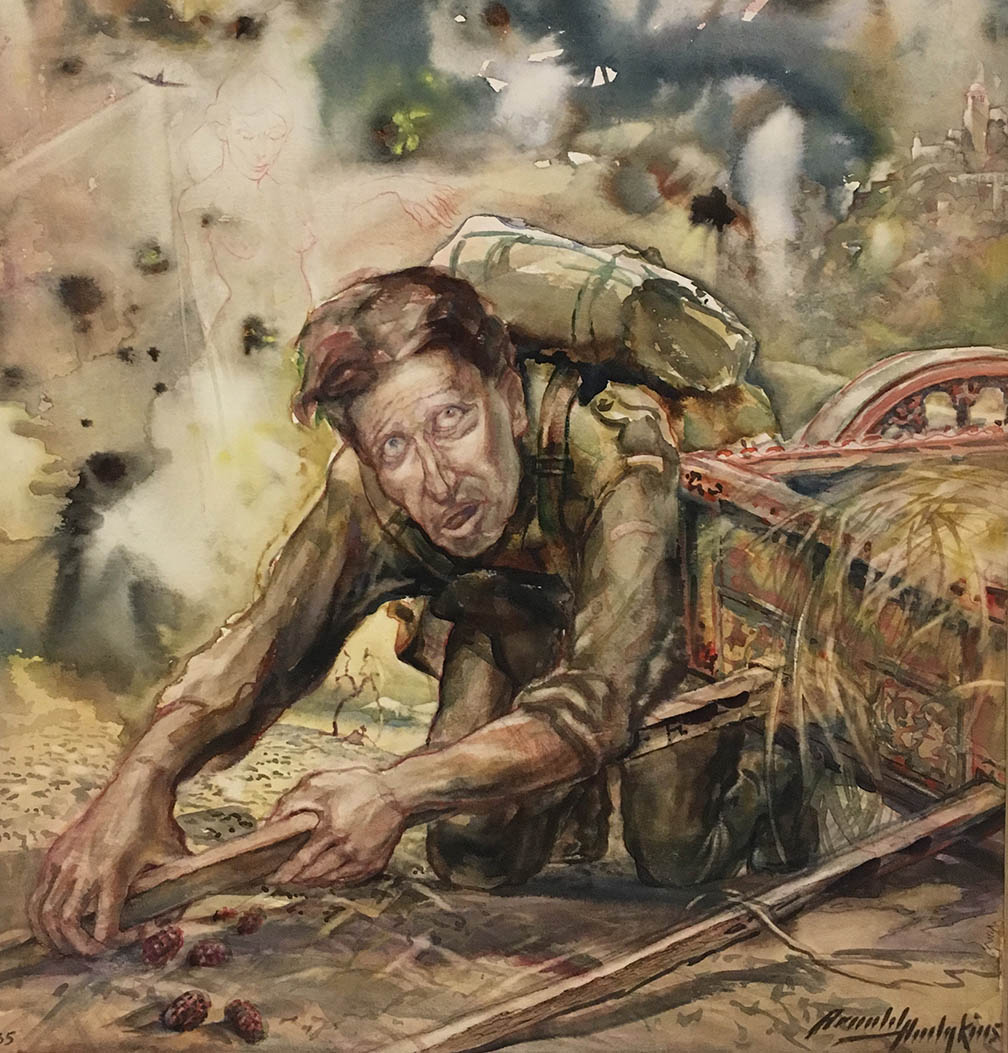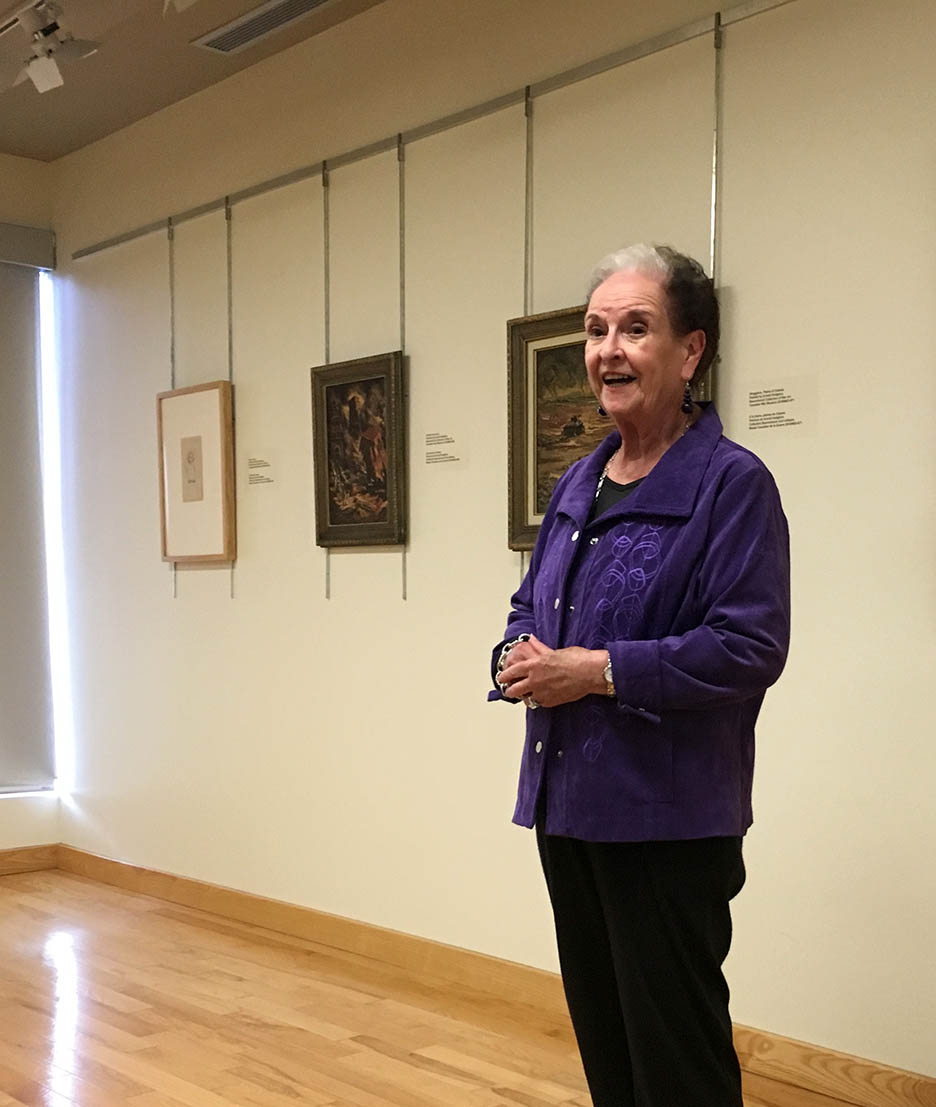
Some things are just meant to happen. About five years ago, a woman in Port Perry made a decision about the artwork that had accumulated around her home for half a century. A large private collection of sketches, water colours and other paintings created by Carol Hodgkins-Smith’s father, Arnold Hodgkins, suddenly went public. The calendar was approaching Nov. 11, and Carol decided her father’s war art deserved a viewing right then and there in her home.
“I think it’s finally time to share my dad’s artwork with the rest of the world,” she told me. She even decided that she would allow some of the artwork to be sold as individual items.
When I visited Carol’s home that fall I couldn’t believe my eyes. Here were portraits of soldiers and civilians, landscapes torn by shelling and combat, and bits and pieces of war weaponry that artist Arnold Hodgkins had recorded on sketch paper or canvas during his service as a field ambulance medic in the Canadian Army during the Second World War.
All the images seemed stressed, and yet each told a story. One, the sketch of an RAF pilot, exhibited the airman’s fearlessness and pride; Hodgkins noted on the sketch the pilot had died the next day in the skies in the battle of Britain.

It turned that I was not the only visitor to Carol Hodgkins-Smith’s open house that autumn of 2014. Erin O’Toole, the MP for the region, stopped by as well, and he was so impressed by the Hodgkins’ work, he purchased one painting Arnold had done of the Canadians landing in Normandy on D-Day.
“I held it in my hands and it was like a Canadian treasure,” he said. But O’Toole also realized what was happening. Hodgkins’ extraordinary collection of war art was leaving the family home piecemeal, going off in a hundred different directions.
“Do not sell another item,” O’Toole told her. “We will make sure we keep this collection together.” It was meant to be. O’Toole learned that the Canadian War Memorial Fund initiated by Max Aitkin (Lord Beaverbrook) during the Great War, still had funds available with which to purchase war art for the national collection.
The Canadian War Museum then visited Hodgkins-Smith’s home in Port Perry, appraised the art and purchased it for the museum completely intact. “As a result, Arnold Hodgkins’ work became part of that very sacred collection of war art from the Second World War,” O’Toole said.

While all this went on, I had simultaneously sought out Arnold Hodgkins’ diaries for my research on military medics. And Carol allowed me to borrow all 19 volumes of the man’s wartime journals. I learned just how completely Hodgkins relied on his art to get him through the war.
During his first call to action – attending the first survivors of the Dieppe raid back in England – Arnold said he had started a hobby. His ambulance comrades turned to stamp collecting, antique buying and jewelry making, while “it had been my good fortune to build up rather a widely representative art portfolio.”
But I discovered from his diaries that his art proved as much an outlet for the way he dealt with what he witnessed as a medic, as it was a record of his journey with Allied liberation armies in Europe. In early December 1943, while attending wounded at the Moro River in Italy, Arnold drove his motorbike over a land mine and was severely wounded.
Months of recovery and rehabilitation followed; one of the first things he asked of the hospital staff around him was for sketch paper and pencils. He drew and he painted. And the result was his wartime collection of hundreds of works.

One painting, that Hodgkins simply identified as “Victim ’43,” shows a frightened soldier, crawling past a broken wagon on the ground. Cowering and drawn, the unidentified warrior hardly seems the conquering hero, but more an emaciated refugee retreating from the chaos around him.

When I saw it in the Kent Ferndale Gallery last Saturday I stopped in my tracks. It was the personification of post-traumatic stress disorder.
“There was not a lot of talk of war when we visited my grandfather,” explained Arnold’s grandson Brent Smith at the exhibit. “But I did get a sniff of what fear was like by looking at that picture.”
The coincidence of all this, is that I had no idea this exhibit was happening last Saturday until just before it happened. I happened to be autographing books just down the block at Books Galore when Erin O’Toole’s office called to inform me of the showing. With minutes to spare, I dashed to the gallery.
The art, the artist’s family, those who had preserved the art in the national collection and curious local citizens were suddenly there to view and recognize the life as an artist. Arnold Hodgkins had come home again.
It was meant to be.
I would love to see this work as I understand from your lecture that he was with my Dad’s unit for awhile.
Arnold was an early influence on my introduction to Art , and the importance of Art in the lives of a countries citizens .
He paid dearly for his insight- The War- and his struggle to achieve the recognition his Art deserved in a Country that seemed to embrace the modern- and it seemed to him- reject the more Traditional approaches to making Art.
Arnold and his lovely wife Iola, always made me feel welcome in their home- and they gave me my first Show of Watercolours at their Deerfoot Gallery.
I grew up often visiting Arnold and Iola in their home and Deerfoot Gallery. They were family friends. I have vivid memories of Arnold, and his deep spirituality, and fortunately, I also have several of his paintings. All these years later, and I still remember him, as if it was yesterday. So wonderful to hear of his paintings in the War Museum. I remember seeing them in his gallery, as he finished them. So haunting, all these years later.